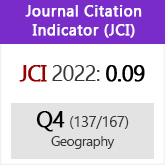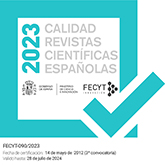The pristine myth and the direct land use pattern in the region of Magellan’s, Chilean Patagonia: forestry, mining and aquaculture
DOI:
https://doi.org/10.3989/estgeogr.201505Keywords:
Patagonia pristine, land use/cover, forest use, mining, aquaculuture, GISAbstract
The current classification methods of land use in remote regions have two serious limitations. The first is the conceptual mixture between land uses and covers, which does not reflect the actual direct use of land. A second limitation is the absence of important uses such as tourism, aquaculture and mining, which impose significant pressures on fragile territories. This paper presents a land use classification method developed specifically for the region of Magellan in the extreme south of Chile. It is a land use classification wide and conceptually clear, which allows an effective determination of the range of land exploitations in Patagonia, determining which areas are used and which remain unused. The method is based entirely on a GIS and is a key input for improving land management. The analysis shows a high percentage of direct use, contrary to the existing pristine perception, which imposes significant challenges for current land management strategies.
Downloads
References
Anderson, B. J. R. (1976): A Land Use And Land Cover Classification System For Use With Remote Sensor Data. Washington D.C., US Government Printing Office.
Breuste, J., Haase, D. & Elmqvist, T. (2013): "Urban Landscapes and Ecosystem Services", in S. Wratten, H. Sandhu, R. Cullen, & R. Constanza (eds.): Ecosystem Services in Agricultural and Urban Landscapes. Chicester,Wiley & Blackwell, pp. 83–104. http://dx.doi.org/10.1002/9781118506271.ch6
Chrisman, N. R. (1991): "The error component in spatial data". Geographical information systems, 1/12: pp. 165-174.
Chrisman, N. R. (1989): "Modelling error in overlaid categorical maps", in M. F. Goodchild y S. Gopal (eds): Accuracy of spatial databases. London, Taylor & Francis, pp. 21-34.
CONAF-CONAMA. (2006). Catastro de uso del suelo y vegetación, región de Magallanes y Antártica Chilena. Monitoreo y actualización. Santiago de Chile, p. 14.
Denevan, W. M. (1992): "The Pristine Myth: The Landscape of the Americas in 1492". Annals of the Association of American Geographers, 82/3, pp. 369–385. http://dx.doi.org/10.1111/j.1467-8306.1992.tb01965.x
Di Gregorio, A., & Jansen, L. J. M. (1997): "A new concept for a land cover classification system". Proceedings of the Earth Observation and Environmental Information 1997, Alejandría, Egipto, Conference, pp. 13-16. PMCid:PMC1051100
Di Gregorio, A. (2005). Land cover classification system: classification concepts and user manual: LCCS (No. 8). Roma, Food & Agriculture Org. PMCid:PMC544341
Duhamel, C. & Vidal, C. (1999): "Objectives, tools and nomenclatures. In Eurostat: Land Cover and Land Use information systems for European Union Policy needs", in: Proceedings of the seminar 1998, Luxembourg 21 – 23 January, EC. PMCid:PMC1736525
Ega-a, P. P. C. & Palma, C. (1999): Catastro y Evaluación de Recursos Vegetacionales Nativos de Chile. Protocolo de Acuerdo CONAF-CONAMA. Santiago de Chile, Universidad Austral de Chile/Pontificia Universidad Católica de Chile/Universidad Católica de Temuco.
Eiten, G. (1968): "Vegetation forms. A classification of stands of vegetation based on structure, growth form of the components, and vegetative periodicity". Boletim do Instituto de Botanica, 4.
European, C. (1993): CORINE Land Cover guide technique. Luxembourg, European Enviroment Agency, OPOCE, 130 pp.
FAO. Departamento de Pesca, Organización de las Naciones Unidas para la Agricultura y la Alimentación, (2009): El estado mundial de la pesca y la acuicultura 2008. Roma, Food & Agriculture Org.. http://www.fao.org/docrep/011/i0250s/i0250s00.htm (Verificada el 1/5/2015)
Fosberg, F. R. (1961): "A classification of vegetation for general purposes". Tropical Ecology, 2, pp. 1-28.
Franklin, J.; Phinn, S. R.; Woodcock, C. E. & Rogan, J. (2003): "Rationale and conceptual framework for classification approaches to assess forest resources and properties", in M. Wulder & S. E. Franklin, (eds): Methods and Applications for Remote Sensing of Forests: Concepts and Case Studies. Dordrecht, Kluwer Academic Publishers, pp. 279-300. http://dx.doi.org/10.1007/978-1-4615-0306-4_10
Fundación CEQUA, (2007): Actualización de las bases para una estrategia para la conservación de mamíferos marinos en la región de Magallanes y Antártica chilena. Informe final. Punta Arenas, 151 pp.
Gallegos, A. & Donoso, J. (1997): "Energía y seguridad nacional". FASOC, 12/1, pp. 42-47.
Haberl, H.; Wackernagel, M.; Krausmann, F.; Erb, K.-H. & Monfreda, C. (2004): "Ecological footprints and human appropriation of net primary production: a comparison". Land Use Policy, 21/3, pp. 279-288. http://dx.doi.org/10.1016/j.landusepol.2003.10.008
Inostroza, L. (2008): "Turismo en la Patagonia: una Amenaza para la Integridad Ecológica del Medio Natural". CIUR, 56, pp. 122.
Inostroza, L. (2012): "Patagonia, Antropización de un Territorio Natural". CIUR, 83, pp. 86.
Kuechler, A. W. & Zonneveld, I. S. (eds.) (1988): Vegetation Mapping. Handbook of Vegetation Science, vol. 10. Dordecht, the Netherlands, Kluwer Academic. http://dx.doi.org/10.1007/978-94-009-3083-4
Loveland, T. R.; Sohl, T. L.; Stehman, S. V.; Gallant, A. L.; Sayler, K. L. & Napton, D. E. (2002): "A Strategy for estimating the rates of recent United States land-cover changes". Photogrammetric Engineering & remote Sen, 68/10, pp. 1091-1099.
Lunetta, R. S. & Elvidge, C. D. (1998): Remote Sensing Change Detection: Environmental Monitoring Methods and Applications. Chelsea, Ann Arbor Press, 318 pp. PMCid:PMC2170192
Martinic, M. (2004): "La minería del carbón en magallanes entre 1868-2003". Historia, I/37, pp. 129-167.
Meinel, G. & Hennersdorf, J. (2002): "Classifications systems of land cover and land use and their challenges for picture processing of Remote Sensing data–Status of international discussion and programs", in: Proc. 3rd Int. Symp. Remote Sens. of urban areas, Istambul, pp. 472-479.
Mueller-Dombois, D. & Ellenberg, J. H. (1974): Aims and Methods of Vegetation Ecology. New York, John Wiley and soons.
Murray, I.; Blázquez, M. & Rullan, O. (2005): "Los cambios en la cobertura de la Tierra. Una revisión bibliográfica desde la Geografía". Revista Bibliográfica de Geografía y Ciencias Sociales, X/571, pp. 1-16.
Pillet, F. (2003): "El espacio geográfico y el estudio del espacio humanizado en la sociedad global". Estudios Geográficos, LXIV/250, pp. 47-62. http://dx.doi.org/10.3989/egeogr.2003.i250.224
RAE, Real Academia Española de la Lengua, (2001): Diccionario de la Lengua Española. Madrid, Espasa Calpe, XXII Edición.
Rogan, J. & Chen, D. (2004): "Remote sensing technology for mapping and monitoring land-cover and land-use change". Progress in Planning, 61/4, pp. 301-325. http://dx.doi.org/10.1016/S0305-9006(03)00066-7
Romero-Calcerrada, R.; Perry, G. L. & Viegas, D. X. (2002): "Landscape change pattern (1984-1999) and implications for fire incidence in the SPA Encinares del rio Alberche y Cofio (Central Spain)", in: Forest fire research and wildland fire safety: Proceedings of IV International Conference on Forest Fire Research 2002 Wildland Fire Safety Summit, Luso, Coimbra, Portugal. November 2002. Millpress Science Publishers. pp. 18-23.
Valera Lozano, A.; A-ó Vidal, C. & Sánchez Díaz, J. (2012): "Cambios en los usos y coberturas del suelo en el municipio de Elx (1956-2005)". Estudios Geográficos, 72/271, pp. 681-703.
UNESCO (1973): International Classification and Mapping of Vegetation. Paris.
Wrbka, T.; Erb, K.-H.; Schulz, N. B.; Peterseil, J.; Hahn, C. & Haberl, H. (2004): "Linking pattern and process in cultural landscapes. An empirical study based on spatially explicit indicators". Land Use Policy, 21/3, pp. 289-306. http://dx.doi.org/10.1016/j.landusepol.2003.10.012
Downloads
Published
How to Cite
Issue
Section
License
Copyright (c) 2015 Consejo Superior de Investigaciones Científicas (CSIC)

This work is licensed under a Creative Commons Attribution 4.0 International License.
© CSIC. Manuscripts published in both the printed and online versions of this Journal are the property of Consejo Superior de Investigaciones Científicas, and quoting this source is a requirement for any partial or full reproduction.All contents of this electronic edition, except where otherwise noted, are distributed under a “Creative Commons Attribution 4.0 International” (CC BY 4.0) License. You may read here the basic information and the legal text of the license. The indication of the CC BY 4.0 License must be expressly stated in this way when necessary.
Self-archiving in repositories, personal webpages or similar, of any version other than the published by the Editor, is not allowed.
















